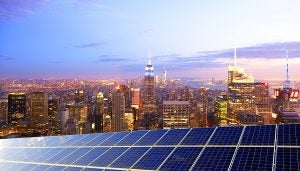By Elizabeth B. Stein, Ferit Ucar
Small distributed energy resources, cutting carbon emissions, and making sure people pay appropriately for participating in the electric system: These have been pillars of Reforming the Energy Vision (REV), New York’s comprehensive initiative to re-think utility regulation and reduce carbon in the power sector.
Cutting carbon pollution – decarbonization – will be difficult as long as a carbon price is in effect only for large generators. That approach creates a risk of shifting emissions from large generators to small ones and creates a disincentive for environmentally-beneficial electrification.
Setting a robust price on carbon and applying it to fossil fuel users of all sizes and types would avoid such results and enable the market to drive down emissions efficiently. But in a world without such a broadly-applied price, designing an appropriate compensation mechanism for small generators that produce both environmental benefits and emissions is an interesting economic policy challenge.
There’s a lot to consider. Let’s unpack the issues.
[Tweet “New lessons in compensating distributed energy resources for environmental attributes”]
Compensating distributed energy resources appropriately
Since 2015, New York’s Public Service Commission, the state’s utility regulator, has engaged in the Value of Distributed Resources (VDER) proceeding to push for the compensation of distributed energy resources to more accurately account for their value by “monetizing externalities,” including “emissions avoidance.”
The initial phase of VDER involved developing a new compensation method exclusively for resources that had traditionally been net metered – or received full retail rate in exchange for the unused electricity they sell back to the grid.
Value=LMP+D+E
This method, called the “value stack,” includes an energy value (LMP), a distribution system value (D), and an environmental value (E). The E value is based on carbon emissions that are avoided when non-emitting distributed energy resources like solar rooftops meet demand instead of large, centralized resources — including many that produce emissions.
But we find that although the value stack method developed in the first phase of VDER was a great start as long as it was applied mostly or exclusively to the non-emitting resources, such as rooftop solar, applying it to emitting generators could create a host of problems.
Small emitting distributed generators don’t fit the framework
The most obvious problem is that the “E value” in the original value stack was calculated based on the difference between carbon emissions from resources on the central electric system from large generators and the carbon emissions from distributed rooftop solar, which is zero-emission. When a distributed generator does produce emissions, this E value is not easily calculated because an emitting resource that starts out with a positive E value (when that resource’s carbon emission rate is lower than that of the central system) could have a negative E value in the future as the central electric system gets cleaner over time.
Still, because of the potential energy and distribution system benefits of certain distributed emitting generators, parties have been trying to find a way to fit them into this initial value stack. One idea has been to give them the benefit of the value stack other than the E value.
Unfortunately, this doesn’t solve the entire problem – because there’s also an issue with the LMP value: The value stack compensates clean distributed resources for “environmental benefit” of being emission-free not just through E value, but also through the LMP value. It would be dysfunctional for a distributed resource that emits to be paid through the LMP value for zero emissions, an environmental benefit that they don’t provide. Here’s how the problem plays out:
- The LMP value is the wholesale clearing price that generators get paid for energy, and the wholesale market is affected by a carbon price applied through the Regional Greenhouse Gas Initiative (RGGI).
- Under RGGI, large generators are required to purchase permits for emitting pollution. The permit price becomes part of a polluting generator’s cost of doing business. So, RGGI makes polluters “internalize” some pollution costs that otherwise would be experienced by society as a whole.
- Pollution permitting results in somewhat higher wholesale prices being paid to generators for energy, but for polluters, this doesn’t mean more profits, since they have to spend money on permits.
- The current value stack design recognizes this dynamic: The E value is set based on the higher of the Social Cost of Carbon or the Renewable Energy Credit price, which is then reduced based on the RGGI permit price because that portion of the carbon cost has been internalized.
- Small generators don’t participate in RGGI so they don’t have to buy emissions permits and don’t pay a price on carbon, even if they burn fossil fuel. If small generators emit and are paid the full wholesale price despite not buying permits to pay the price on carbon, they would receive a windfall because they’d be profiting from their ability to avoid a price on carbon that other polluters have to pay. And if the carbon price internalized in the wholesale market increases, the size of this windfall could, too.
So, applying the value stack to emitting distributed generators does not result in proper compensation, due to value for environmental benefits being embedded into both the environmental and energy values of the formula.
Making the best of the situation
An economy-wide price on carbon would avoid these problems. It would enable relatively efficient fuel users to enjoy a competitive advantage compared to less efficient fuel users. In the absence of an economy-wide price on carbon – and especially given the existence of a price on carbon that would apply to some generators but not others – designing a fair and accurate compensation mechanism is much harder. We need to properly, and very cautiously, value the environmental attributes of distributed energy resources that produce emissions.










